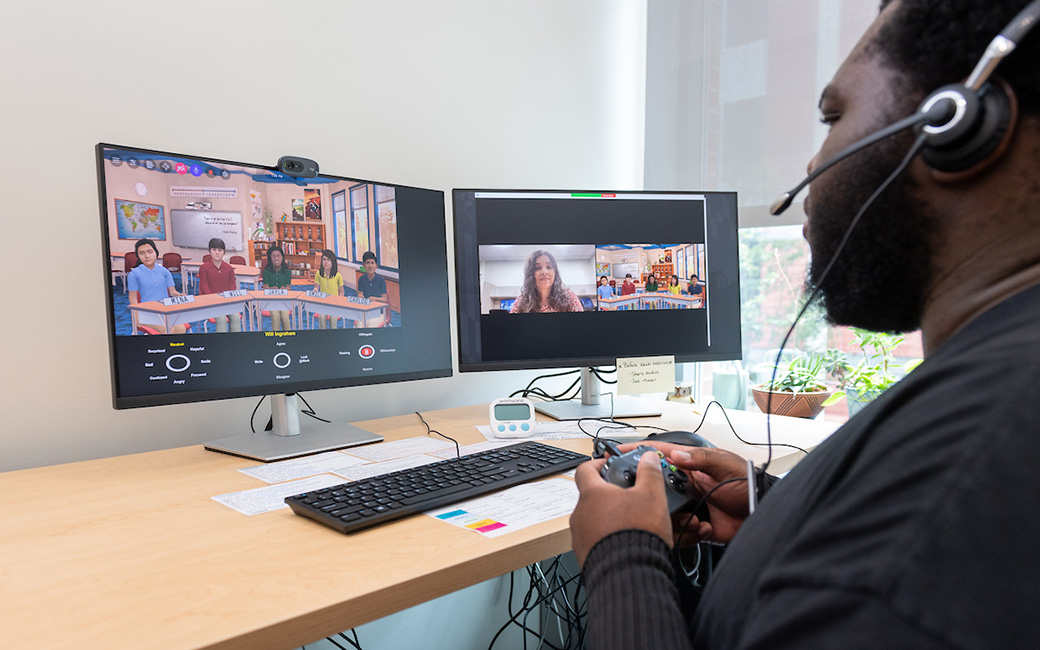National Science Foundation-funded research facilitates STEM teaching
TU professor studies avatar-based classroom simulations in three-year, $3 million NSF grant
By Rebecca Kirkman on January 11, 2022

Talking into a headset and quickly clicking buttons on an Xbox gaming controller, voice actor and simulation specialist Michael Oduro ’22 simultaneously portrays five student avatars in a simulated middle school science classroom as the avatars participate in a real-time discussion with a student teacher.
The avatar-based simulation is one of three online activities to support science teacher education, collectively called the Online Practice Suite (OPS), being explored through a three-year, $3.2 million National Science Foundation grant (#2037983) designed by collaborators across five institutions, including Towson University.
A space for focused learning
The simulation provides student teachers, also known as pre-service teachers, the opportunity to practice engaging students in scientific argumentation-based discussions—an important teaching practice in STEM education that pre-service teachers typically have limited opportunities to try out and refine before entering the field.
“This kind of work has been done to enhance pre-service teacher learning since before COVID. However, during COVID, which is when the OPS project began, the simulations provide a way for pre-service teachers to have approximations of practice even when they could not be in field placements,” says Pamela Lottero-Perdue, a professor of science and engineering education at TU and one of the grant’s co-principal investigators (PIs).
Even with student teachers back in classrooms, the tool provides a standardized, discussion-based teaching scenario where students can break down complex teaching into smaller components, which can be practiced with greater intensity to improve their skills over time.
“It’s an opportunity for pre-service teachers to learn how to facilitate evidence-based discussions to help their students engage in argumentation, moving toward consensus,” Lottero-Perdue explains. “These are situations that are difficult to practice in the field, in part because they do not occur frequently or in sync with pre-service teachers’ field experiences. The simulation allows them to focus on and learn from this ambitious practice.”
Other collaborators on the project include the Educational Testing Service (ETS), the lead institution on the project; Indiana University, Bloomington; the Massachusetts Institute of Technology; and University of North Carolina, Chapel Hill.
Exploring innovative, technology-based solutions
The work builds on prior NSF-funded research (grant #1621344) for which Lottero-Perdue was a teacher educator participant, which examined how pre-service teachers grew in their abilities to facilitate argumentation discussions with repeated practice in the Mursion® simulated environment. The OPS project work also builds on School of Emerging Technologies-supported research on the use of simulated classroom environments in science and engineering with in-service teachers, with Lottero-Perdue as PI and co-PIs Jamie Mikeska (ETS) and Laila Richman, associate dean of the College of Education and associate professor of special education. It also utilizes Mursion®, the virtual reality education software licensed by the College of Education in its SIMTeach@TU Simulation Lab.
Since the grant began in 2020, Lottero-Perdue, working with research scientists at ETS, has contributed to the effort of conducting hundreds of simulated classroom sessions with pre-service teachers with help from an interdisciplinary TU team, including the College of Education and College of Fine Arts & Communication.
Throughout the process, they studied pre-service teachers’ perception and engagement with the avatar-based simulation and found the tool to be a productive and innovative technology-based approach to supporting science teacher learning, as detailed in a November 2022 article published in the Journal of Technology and Teacher Education.
Building a collaborative, interdisciplinary team

The project also provided opportunities for TU students.
When looking to hire simulation specialists, Lottero-Perdue reached out to voice and acting professor Steven Satta in the Department of Theatre Arts, who connected her with undergraduate acting major Oduro and M.F.A. in theatre arts candidate Skye Fort ’22, both of whom graduated during the project.
The job—which required nearly 100 hours of training on the Mursion elementary and middle school environments and on OPS project scenarios—allowed Oduro and Fort to apply acting skills in a new way. It also allowed them to work in their field when most theatres and other productions were closed due to COVID.
“I’m a big gamer, and I got into voice acting a few years before working on this project,” says Oduro, who began working as a simulation specialist in August 2021, “So I was familiar with the controller and able to utilize skills I already had in voice acting and improv. It was a great way to continue acting throughout the pandemic, and it’s a skill I can take with me and will look good on a resume.”
The interdisciplinary nature of the project brought a new perspective to Fort’s graduate studies.
“The work addressed a lot of the questions I was asking as a graduate student but in a totally different area,” says Fort, who began working as a simulation specialist in January 2021. “Especially in this pandemic time, I was thinking ‘how can theatre happen when we can't be together?’ And ‘how can technology, art and performance serve each other in different ways?’”
About the simulation team and the OPS project team, Lottero-Perdue offered, “We each bring unique strengths and are willing to learn from each other. We all see ourselves as learners as well as experts.”